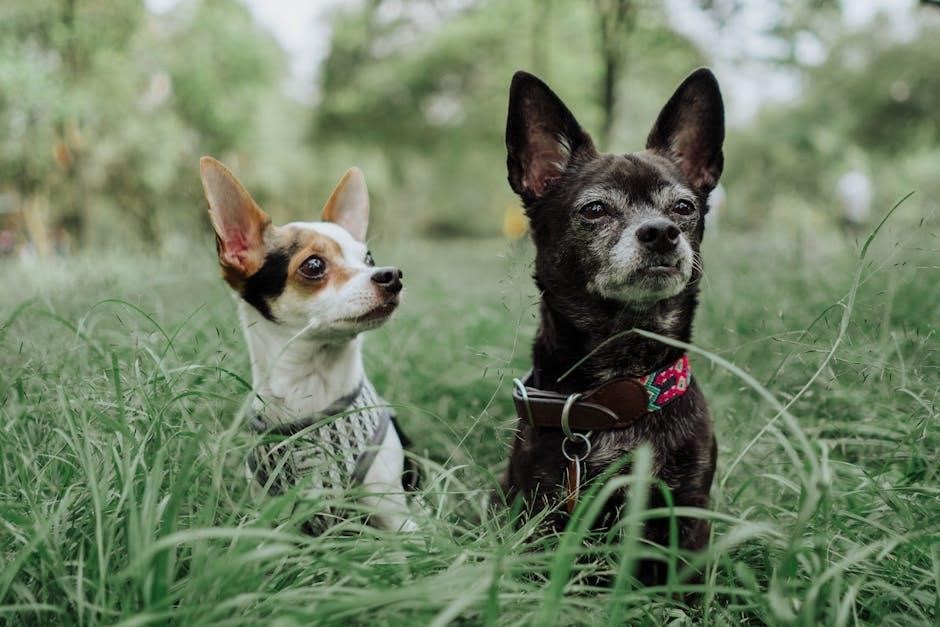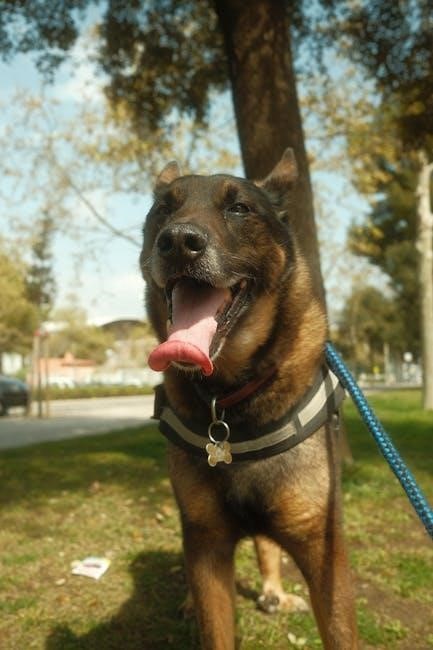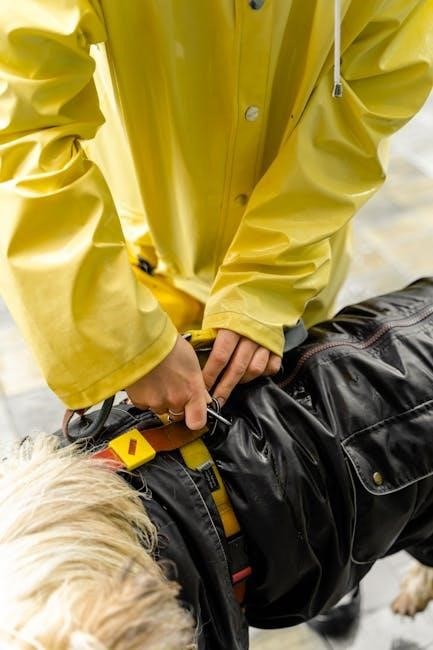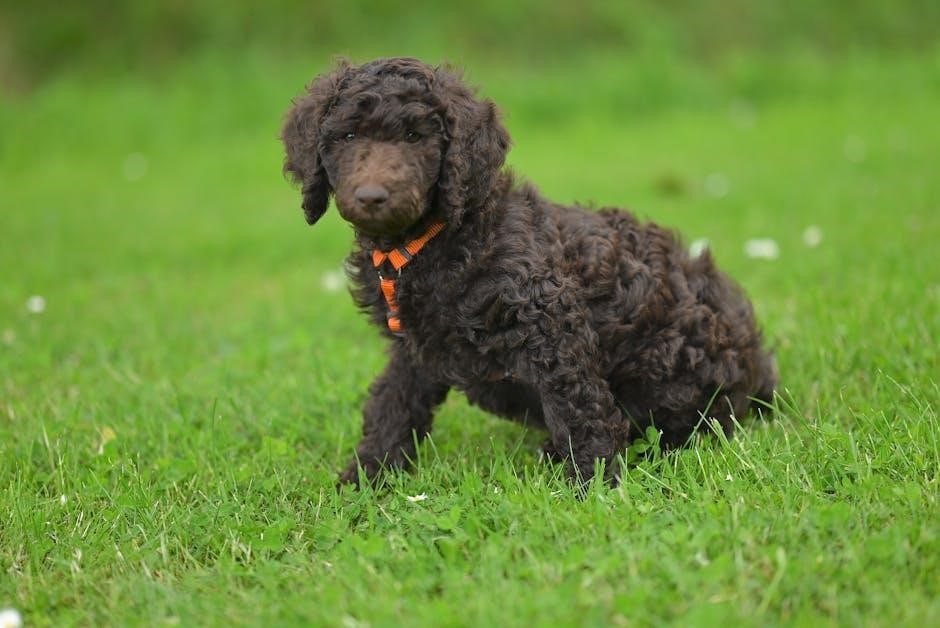dog guide harness
A dog guide harness is a specialized tool designed to assist visually impaired individuals, providing comfort, support, and clear communication between the dog and handler.
1.1 Definition and Purpose
A dog guide harness is a specifically designed vest or strap system worn by trained service dogs to assist individuals with visual impairments. Its primary purpose is to provide clear communication and control between the dog and handler, ensuring safe navigation. The harness is built for comfort and durability, featuring adjustable straps and padding to distribute weight evenly. It signals the dog to focus on its working role while maintaining handler control and balance.
1.2 Brief Overview of Guide Dogs
Guide dogs are highly trained canine companions that assist individuals with visual impairments, ensuring their safety and independence. These dogs undergo extensive training to navigate obstacles, stop at curbs, and avoid hazards. Breeds like Labradors, Golden Retrievers, and German Shepherds are commonly used due to their intelligence and temperament. When wearing a harness, guide dogs focus solely on their working role, providing reliable guidance and enabling their handlers to move confidently through various environments.
History and Evolution of Dog Guide Harnesses
Dog guide harnesses originated in World War I, initially simple leather straps. Over time, designs evolved to improve comfort, functionality, and durability, incorporating modern materials and ergonomic features.
2.1 Early Developments
The first dog guide harnesses emerged during World War I, crafted from basic leather straps to aid soldiers with visual impairments. These early models were rudimentary, focusing solely on functionality without ergonomic design. They laid the groundwork for future innovations, emphasizing the importance of a reliable connection between handler and dog. Despite their simplicity, these early harnesses marked the beginning of a transformative tool in assistance technology.
2.2 Modern Advances
Modern dog guide harnesses feature enhanced materials like durable nylon and padded chest plates for comfort. Adjustable straps ensure a tailored fit, while reflective strips improve visibility. Technology integration, such as GPS tracking and sensors, enhances safety and communication. Customizable designs cater to individual needs, and ergonomic engineering reduces strain on both the dog and handler, making these harnesses more functional and user-friendly than ever before.

How Dog Guide Harnesses Work
Dog guide harnesses are tools that enable clear communication between the dog and handler, providing support and balance while navigating obstacles, ensuring safe and efficient mobility for the handler.
3.1 Mechanics and Components
Dog guide harnesses consist of a chest plate, padded straps, and a handle. The chest plate distributes force across the dog’s ribcage, while the handle provides control for the handler. Straps ensure a secure fit, and padding enhances comfort during long walks. The design allows the dog to move freely while maintaining focus. These components work together to ensure effective communication and balance between the dog and handler, enabling safe navigation of various environments.
3.2 The Role of the Handler
The handler plays a vital role in guiding the dog, relying on the harness to communicate commands and feedback. They must maintain a consistent grip on the handle, providing gentle cues to direct the dog. Handlers also ensure the harness fits correctly, adjusting straps for comfort and control. Effective teamwork between handler and dog is essential for navigating obstacles, with the handler interpreting the dog’s movements and the dog responding to the handler’s guidance seamlessly.
Types of Dog Guide Harnesses
Dog guide harnesses come in various types, including padded, mesh, and dual-clip designs, each offering unique benefits for comfort, durability, and functionality.
4.1 Padded Harnesses
Padded harnesses are designed for enhanced comfort, featuring cushioned chest plates and straps to reduce pressure points. They are ideal for dogs that work long hours or in challenging terrains, providing extra support and minimizing discomfort. The padding ensures better weight distribution, making it easier for the dog to maneuver without strain. Additionally, these harnesses often include adjustable straps and reflective materials for increased visibility and safety.
4.2 Mesh Harnesses
Mesh harnesses are lightweight and breathable, ideal for dogs working in hot climates or requiring minimal restriction. The mesh material allows airflow, preventing overheating, while maintaining durability. These harnesses are less bulky, offering flexibility and ease of movement. They are perfect for short-term tasks or dogs sensitive to heavy gear, ensuring comfort without compromising functionality. Mesh harnesses are a practical choice for handlers seeking a balance between support and ventilation.
4.3 Dual-Clip Harnesses
Dual-clip harnesses feature two attachment points, offering versatility for various activities. One clip is typically located on the back for everyday walking, while the second is on the chest for pulling or training. This design distributes force evenly, reducing strain on the dog. Durable and adjustable, dual-clip harnesses are ideal for active dogs and handlers needing reliable, multifunctional gear. They provide comfort and control in diverse situations, making them a popular choice for guide dog handlers.

Importance of Proper Sizing and Fit
Proper sizing and fit are crucial for comfort, mobility, and effectiveness. A well-fitted harness ensures even weight distribution, preventing discomfort and maximizing the dog’s ability to guide safely.
5;1 Measurements Needed
To ensure a proper fit, key measurements include the dog’s belly circumference, back bridge length, chest bridge length, and neck measurement. These dimensions help determine the optimal harness size, ensuring comfort and mobility. Accurate measurements prevent issues like chafing or restricted movement. Manufacturers often provide sizing charts based on these metrics. Handlers should carefully measure their dogs and consult the charts to select the best fit, ensuring the harness functions effectively without causing discomfort or hindering performance.
5.2 Factors Affecting Fit
Proper fit is influenced by the dog’s breed, size, and body type. Harnesses must accommodate chest circumference, shoulder structure, and weight distribution. Adjustable straps ensure comfort and prevent chafing. Breed-specific designs address unique physical traits, while materials like padded or mesh panels enhance comfort. Regular adjustments are needed as dogs grow or gain/lose weight. Correct fit ensures optimal performance and prevents discomfort or restricted movement during guiding tasks.
Training a Dog to Use a Guide Harness
Training involves gradual introduction to the harness, positive reinforcement, and clear commands. Dogs learn to associate the harness with focus and work, ensuring calm and effective guidance.
Introducing a dog to a guide harness begins with gradual exposure, allowing the dog to see, smell, and feel the harness. Start by letting the dog explore it at their own pace, using treats to create a positive association. Keep initial sessions short to avoid overwhelming the dog. Consistency and patience are key to helping the dog understand the harness’s purpose and feel comfortable wearing it.
6.2 Etiquette and Public Access
Handlers should maintain control and ensure their dog remains focused in public. Etiquette includes avoiding distractions and keeping the dog calm. The public should refrain from petting or feeding guide dogs while they are working. Service animal laws grant access to all public spaces, ensuring independence for handlers. Proper certification and clear identification are essential for smooth interactions in public settings. Respect and understanding from the public are crucial for effective teamwork between the handler and their guide dog.
Materials and Durability
Dog guide harnesses are typically made from durable materials like nylon or padded elements, ensuring both comfort and longevity. High-quality construction, including reinforced stitching and adjustable straps, enhances their lifespan, making them reliable for daily use.
7.1 Common Materials Used
Dog guide harnesses are crafted from durable materials such as nylon, polyester, and padded neoprene. These materials ensure comfort, flexibility, and strength. Nylon is often used for its resistance to wear and tear, while polyester adds lightweight durability. Padded elements, like neoprene, provide cushioning, reducing strain on the dog’s skin. Additionally, some harnesses feature breathable mesh panels to enhance airflow and prevent overheating during extended use.
7.2 Ensuring Longevity
Regular cleaning and proper drying of the harness are essential to prevent damage and extend its lifespan. Storing the harness in a cool, dry place avoids abrasions and moisture buildup. Inspecting for wear and tear, such as frayed straps or broken buckles, ensures safety and functionality. Conditioning materials periodically can maintain flexibility and prevent cracking. These practices help preserve the harness’s quality, ensuring reliable performance for both the dog and handler over time.

Legal Aspects and Certifications
Guide dogs are protected under service animal laws, ensuring public access. Certifications for harnesses, while not mandatory, ensure they meet safety and functionality standards for guide dog use.
8.1 Service Animal Laws
Service animal laws, such as the Americans with Disabilities Act (ADA), protect the rights of visually impaired individuals to use guide dogs in public spaces. These laws ensure that guide dogs, equipped with their harnesses, are allowed access to all public areas, including restaurants, transportation, and stores, without discrimination. The harness serves as a visible indicator of the dog’s working status, aiding in public recognition and compliance with legal requirements.
8.2 Certifications and Standards
Certifications for dog guide harnesses ensure they meet specific safety and functionality standards. Organizations like the International Guide Dog Federation set criteria for harness design, durability, and comfort. These standards often involve rigorous testing, including load and stress trials, to validate the harness’s reliability. Compliance with these certifications guarantees that guide dogs can perform their duties effectively, while also meeting accessibility and legal requirements for service animals.

Maintenance and Care Tips
Regular cleaning with mild detergents and proper storage in a dry place are essential to maintain the harness’s quality and longevity, ensuring hygiene and durability for consistent use.
9.1 Cleaning and Hygiene
Regular cleaning of a dog guide harness is essential to maintain hygiene and prevent bacterial growth. Use mild soap and lukewarm water, avoiding harsh chemicals. Gently scrub removable padding and straps, then rinse thoroughly. Allow the harness to air dry to prevent moisture buildup. Regular inspections for wear and tear are also crucial to ensure the harness remains functional and safe for use. Cleaning after each use helps extend its lifespan and keeps it hygienic for the dog.
9.2 Storage and Handling
Proper storage and handling of a dog guide harness ensure its longevity and functionality. Store it in a cool, dry place, away from direct sunlight. Avoid folding or creasing the harness, as this can damage the material. Lay it flat or hang it to maintain its shape. Handle the harness with care, avoiding exposure to harsh chemicals or abrasive surfaces. Regularly inspect for wear during storage and clean as needed to preserve its condition and ensure optimal performance when in use.

Testimonials and User Experiences
Handlers praise dog guide harnesses for improving navigation and confidence. Many share success stories of enhanced mobility and independence, highlighting the harness’s role in transforming their daily lives.
10.1 Handler Feedback
Handlers consistently praise dog guide harnesses for their comfort, durability, and ease of use. Many report improved navigation and confidence, emphasizing how the harness enhances their daily mobility and independence. Feedback highlights the importance of proper fit and adjustability, ensuring both handler and dog can work efficiently. Positive experiences often mention the harness’s role in strengthening the bond between the handler and their guide dog, fostering trust and reliability in various environments.
10.2 Success Stories
Many users share inspiring stories of how dog guide harnesses have transformed their lives. These harnesses enable greater independence, allowing individuals to navigate safely and confidently. Success stories often highlight improved mobility, enhanced trust between handler and dog, and the ability to participate fully in daily activities. Users frequently credit the harness for fostering a stronger bond with their guide dogs, creating a more effective and reliable partnership in various environments and situations.

Common Challenges and Solutions
Common challenges include sizing issues and behavioral difficulties. Solutions involve ensuring proper fit, using positive reinforcement training, and consistent practice in various environments for effective partnerships.
11.1 Sizing Issues
Sizing issues are common, as improper fit can cause discomfort or restricted movement. Manufacturers often provide detailed measurement guides, including belly circumference, chest bridge, and back length. Ensuring accurate measurements is crucial for optimal comfort and functionality. Adjustable straps and customizable designs help address sizing challenges. Proper fit is essential to prevent chafing or limited mobility, ensuring the dog remains comfortable and focused while working. Always follow sizing charts and consult professionals if needed for the best results.
11.2 Behavioral Challenges
Behavioral challenges, such as anxiety or excitement, can affect a dog’s performance. These issues often arise from improper introduction to the harness or environmental stressors. Consistent training, positive reinforcement, and gradual desensitization are key solutions. Handlers should ensure the dog associates the harness with positive experiences. Professional guidance can help address persistent behavioral problems, ensuring the dog remains focused and calm during work. Early intervention is crucial for long-term success.

Future Trends in Guide Harness Design
Future trends in guide harness design include integration of smart technology and eco-friendly materials, enhancing functionality, comfort, and sustainability for both dogs and handlers effectively and responsibly.
12.1 Smart Technology Integration
Smart technology integration in guide harnesses includes embedded sensors for navigation, GPS tracking, and health monitoring. These innovations enhance the dog’s ability to assist handlers, improving safety and communication. Advanced features like vibration feedback and voice commands can guide dogs more effectively, while real-time data sharing ensures optimal performance and care. This seamless blend of technology and tradition revolutionizes the role of guide dogs in assisting individuals with visual impairments, making daily tasks easier and more efficient.
12.2 Eco-Friendly Materials
Eco-friendly materials are becoming a priority in guide harness design, reducing environmental impact while maintaining durability. Recycled nylon, organic cotton, and biodegradable polymers are increasingly used. These materials offer the same functionality as traditional options but with a lower carbon footprint. Manufacturers are also exploring recyclable hardware and sustainable production methods. This trend aligns with growing consumer demand for environmentally responsible products, ensuring guide harnesses support both users and the planet.

Accessories and Additional Features
Accessories like reflective strips, ID tags, and detachable pouches enhance functionality. Additional features, such as GPS trackers and customizable patches, improve safety and personalization for guide dogs.
13.1 Optional Attachments
Optional attachments for dog guide harnesses include reflective strips for visibility, ID tags for identification, and detachable pouches for carrying small items. These additions enhance functionality and safety, allowing handlers to customize their gear according to specific needs. Reflective strips improve visibility in low-light conditions, while ID tags ensure the dog can be easily identified if separated from its handler. Detachable pouches provide convenient storage for essentials like treats or medical supplies, making outings more efficient and stress-free. These attachments are designed to integrate seamlessly with the harness, maintaining comfort and mobility for both the dog and handler.
13.2 Customization Options
Customization options for dog guide harnesses allow handlers to tailor the gear to their specific needs. Adjustable straps ensure a precise fit, while padding can be added for extra comfort. Some harnesses offer interchangeable chest plates or name tags for personalization. Colors and designs vary, catering to individual preferences. These options ensure the harness is both functional and comfortable, adapting to the unique requirements of the handler and their dog, whether for daily use or special occasions. Customization enhances both aesthetics and performance, providing a tailored solution for guide dog teams. It ensures optimal comfort and functionality, making every outing more enjoyable and efficient.

Choosing the Right Harness
Selecting the right harness involves considering the dog’s size, breed, and comfort needs, ensuring proper fit and functionality for efficient guidance and support.
14.1 Factors to Consider
When selecting a dog guide harness, consider the dog’s size, breed, and comfort needs. Ensure proper fit by measuring girth, chest, and neck. Durability and ease of use are crucial. The harness should align with the dog’s specific needs, such as mobility or terrain challenges. Additionally, assess the material quality, weight distribution, and adjustability features. The handler’s comfort and control should also be prioritized for effective communication and guidance. Always check for certifications and reviews to ensure reliability.
14.2 Making the Decision
Making the decision involves evaluating the dog’s specific needs, handler preferences, and long-term functionality. Prioritize comfort, durability, and ease of use. Consider trying the harness to ensure proper fit and comfort for the dog. Seek feedback from experienced handlers or trainers. Additionally, consult with guide dog organizations or professionals to confirm the best choice for both the dog and handler, ensuring optimal performance and satisfaction.
Dog guide harnesses are indispensable tools for visually impaired individuals, offering independence and confidence. Proper sizing, comfort, and functionality are critical for effective use. By understanding the types, materials, and training involved, users can make informed decisions. As technology advances, future harnesses may integrate smart features and eco-friendly materials, further enhancing their role in assisting guide dogs and their handlers. The right harness can transform lives, ensuring safety and mobility for years to come.
